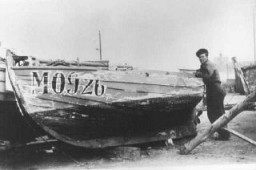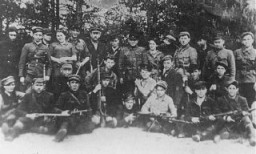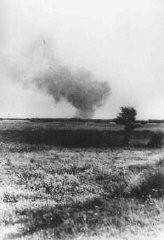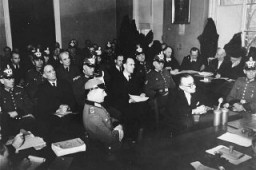
Resistance inside Germany
Resistance inside Germany Despite the high risk of being caught by police with the help of their many informers, some individuals and groups attempted to resist Nazism even in Germany. Socialists, Communists, trade unionists, and others clandestinely wrote, printed, and distributed anti-Nazi literature. Many of these rebels were arrested and imprisoned in concentration camps.
There were many plots to assassinate Hitler during the war. After the important Soviet victory at Stalingrad in early 1943, when it looked as though the tide was turning against the German army, a serious assassination attempt was planned by a group of German military officers and carried out in 1944. Hitler escaped the bomb blast with minor injuries. The four leaders of the conspiracy were immediately shot. Later, 200 other individuals convicted of involvement in the plot were executed.
Of the Germans who opposed Hitler's dictatorship, very few groups openly protested the Nazi genocide against Jews. The "White Rose" movement was founded in June 1942 by Hans Scholl, a 24-year-old medical student at the University of Munich, his 22-year-old sister Sophie, and 24-year-old Christoph Probst. Although the exact origin of the name "White Rose" is unknown, it clearly stands for purity and innocence in the face of evil. Hans, Sophie, and Christoph were outraged that educated Germans went along with Nazi policies. They distributed anti-Nazi leaflets and painted slogans like "Freedom!" and "Down With Hitler!" on walls of the university. In February 1943, Hans and Sophie Scholl were caught distributing leaflets and arrested. Together with their friend Christoph, they were executed four days later. Hans's last words were "Long live freedom!"
Key Dates
December 22, 1942
"Red Orchestra" spy executed in Berlin
Arvid Harnack is executed for treason in Berlin. Harnack is a leading figure in the wide-ranging Soviet spy network, dubbed the "Red Orchestra" by the Gestapo (secret state police). The "Red Orchestra" is active in Belgium, the Netherlands, France, and inside Nazi Germany. Harnack, a leading figure in the group active inside Germany, was involved in German economic planning. He sought to end Adolf Hitler's dictatorship by helping the Soviet Union defeat Germany. As early as 1936, Harnack began to pass on secret information about German armament production to the Soviet Union. During the war, Harnack combines espionage for the Soviet Union with sabotage and other acts of opposition to Hitler. In 1942, the Gestapo begins watching Harnack. He is then arrested, tortured, and condemned to death. Harnack is strangled and hung from a meat hook. Most of the remaining leaders of the spy network are also arrested and brutally killed.
February 22, 1943
Hans and Sophie Scholl executed in Munich
Hans and Sophie Scholl (brother and sister) are executed in Munich. They had founded the White Rose opposition group in 1942. Both are students at the University of Munich. They write and distribute leaflets opposing the Third Reich. The last White Rose leaflet, which the Scholls scattered in the entrance hall of the University of Munich on February 18, 1943, arouses a particular stir. The leaflet declares that "The day of reckoning has come, the reckoning of German youth with the most abominable tyranny that our people have ever suffered." They are reported by the building janitor to the Gestapo (secret state police) and arrested, along with four others. They are brought before the People's Court. Sophie and Hans are convicted of treason and beheaded.
July 20, 1944
Bomb explodes in Hitler's eastern headquarters
Military reverses following the Soviet victory at Stalingrad in 1943 cause increasing discontent, in the German military, with Adolf Hitler. A small group of high-ranking military officers plans a coup against Hitler. Colonel Claus von Stauffenberg, an aide on the general staff of the German armed forces, places a briefcase containing a bomb next to Hitler at his headquarters in Rastenburg, in eastern Germany. During a briefing on the military situation on the eastern front, the powerful bomb explodes, shattering the building. Stauffenberg, who made an excuse to leave after placing the bomb, sees the explosion and returns to Berlin to report Hitler's death. However, the weighty conference table used for military briefings shields Hitler from the full force of the explosion. He survives with minor burns, damaged ear drums, and partial paralysis in his right arm. Stauffenberg is arrested and shot. The other participants of the conspiracy are arrested, tortured, tried for treason, and then brutally executed. They are strangled and hung from meat hooks.






